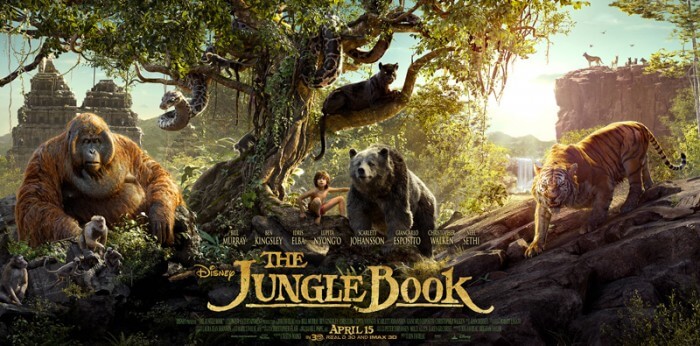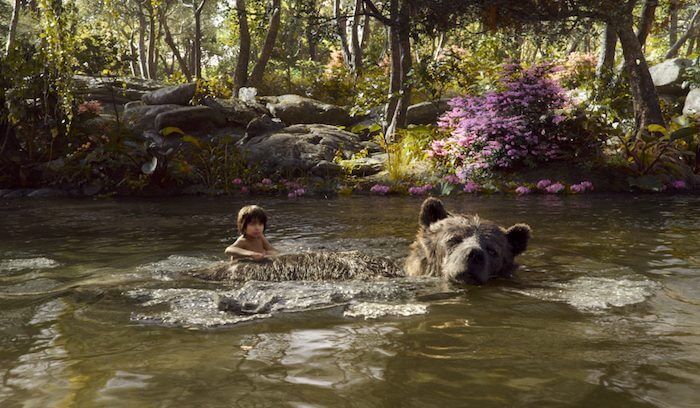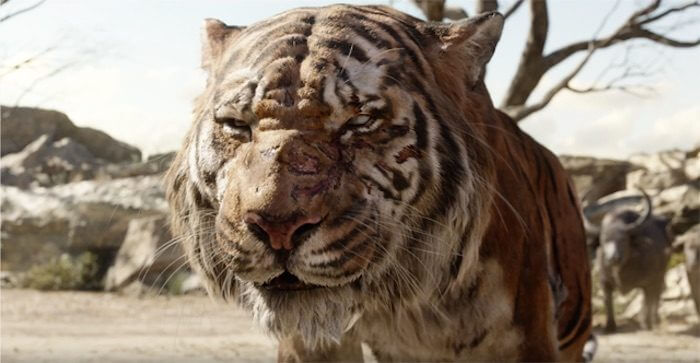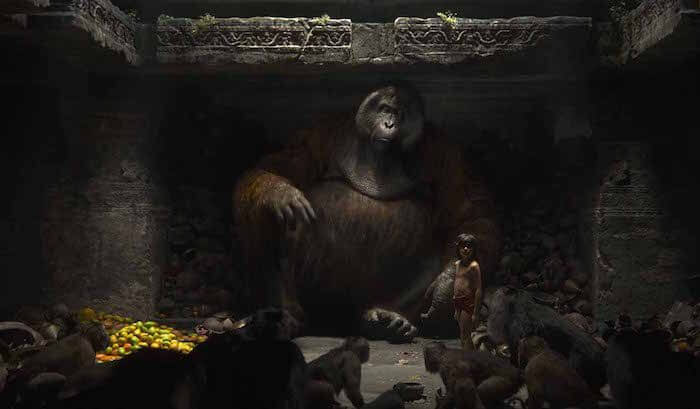The Jungle Book is a beautiful “live action” adaptation
The Disney camp is going full steam ahead with their commitment to live-action remakes of classic animated movies. The latest in what’s promised to be a long line of reboots is the Jon Favreau-directed, CGI-heavy big screen adaptation of The Jungle Book, and the new movie proves to be an exceptional showcase of modern digital animation. That said, the weakest element in 2016’s first big Disney spectacle (don’t forget, Marvel is now Disney’s baby) is the human aspect, and I can’t help long for an all-animal Lion King movie in the same style.
As a family friendly live-action update to one of the most cherished animated classics, The Jungle Book is sure to please most audiences. It’s cute, beautiful, surprising, frightening, and inspiring while staying true to both the original Disney classic as well as the Rudyard Kipling source material. Not without a few faults, The Jungle Book previews a new wave of anthropomorphic animal drama aimed at exploring humanity’s moral dilemmas.
Read my review of Disney’s The Jungle Book after the jump.
For the most part, the Honest Trailer for The Jungle Book from Screen Junkies nailed how I feel about the 1967 animated movie. So, going into the live-action remake I wasn’t really excited or overly cynical, and I’d heard good things from reputable sources. Coming out the other end, I still couldn’t lean very far in either direction, even if I enjoyed myself for the most part. It’s good, don’t get me wrong, but other than the CGI accomplishment it’s hard to gush over The Jungle Book. So, let’s get the digital effects their due. Disclaimer: I did not see this movie in 3D. No excuses outside of it wasn’t available in my area, but I know that would have been the ideal way to view The Jungle Book. There’s a lot of depth to be played with in this fully realized jungle, and I feel like I missed a level of visual pleasure 3D viewers will enjoy. That said, for the most part, from start to finish I was really impressed with the technical level and immersive digital camera work that went into bringing The Jungle Book to life. Lots of noticeably varied levels of bokeh and focus pulling contributes to what sets the movie apart from its predecessors, and I’ve never seen animals at this scale look quite this good. But that’s the movie’s pitfall as well.
In a Twitter Q&A compiled by the folks over at SlashFilm, Favreau explained that the movie was shot entirely using CGI locations. “None are real. All are CGI. The whole movie was shot in downtown LA. … Mowgli floating down the river on Baloo’s belly singing was difficult to recreate with real physics. Lots of R&D.” On one hand, this is astounding. Fur and scenery has never been better, and the sweeping camera pans as well as meticulously created digital cinematography is beautiful. On the other hand, this is still actors recording lines in a sound stage, and Mowgli (played by newcomer Neel Sethi) is tasked with holding up the human element entirely. I can’t help but think back to disheartening stories from sets of movies like the Star Wars I-III and the Hobbit films. To get critical, if you look for it you can see the hard edges and uncanny valleyesque way that Mowgli just doesn’t quite layer into some scenes. He’s there, but he’s not there, and in a world that’s so exceptionally crafted it’s hard not to notice the only human actor trying to fit in. It’s a terribly nit-picky critique, but it’s literally one of the only technical faults of the film.
Throughout the movie, I kept imagining a new version of The Lion King in the same style, completely void of humans, and it made me a little giddy. There are moments in The Jungle Book that could be concept tests for The Lion King (the stampede, the tiger body and facial movements, and the assembly of the animals around the watering hole). Plus, the voice talent is totally still around! Jeremy Irons back as Scar? Matthew Broderick, Nathan Lane, and Ernie Sabella back as Simba, Timon, and Pumba? Cheech and Whoopi Goldberg?! I’m sold. Favreau, make it happen.
Back to The Jungle Book, this adaptation is surprisingly dark, but that comes with the territory of realistic animals on screen. Instead of going the full family friendly route, the movie finds a middle ground between the camp of the cartoon (with two on-screen songs that didn’t feel forced – sung by Bill Murray/Sethi and Christopher Walken) and the animalistic aspects of Kipling’s original story. So, while one minute we’re floating down a river with Mowgli playing drums on Baloo’s belly as they both bellow out “Bare Necessities,” the next we’re watching two angry jungle cats tear at each other in real National Geographic fashion. Don’t be surprised if your toddler has nightmares about tigers or giant apes after The Jungle Book. I had a discussion after the movie, with my brother saying it was too “kid friendly” for his taste, and I countered that without the songs it might be a little too complex and even a bit scary for the toddler crowd. And that’s who filled our showing on Saturday. Our moderately full theater was mostly occupied by rows of 3-8 year olds with mommy tag-a-longs, and I’d be surprised if those kids could understand 1/3 what was going on. So, it’s an interesting film to dissect on that level, and The Jungle Book is an intriguing example of the direction family friendly movies have gone.
Story is another mixed bag for The Jungle Book. The movie’s moral dilemma stems from Mowgli torn between being an animal and being a man, and the notion isn’t necessarily a novel one any more. There’s really not a lot of motivation or driving force for either the characters or the audience outside of Bagheera’s occasional soapboxing. It’s funny, but I had a hard time placing why the plot felt so familiar at first, and then I remembered I recently watched the remade version of Clash of the Titans (Liam Neeson, Sam Worthington) and could almost pick out lines word-for-word that were shared between the two movies. Perseus doesn’t want to be part God. Mowgli doesn’t want to be part man. Again, maybe I’m being too critical, but there’s a very thin thread holding the story together, and it’s unfortunately been unraveled a few times since 1967.
The high points of the movie, for fans and newcomers alike, are definitely going to be the voice acting talent behind the primary animal characters. Sure, the CGI is gorgeous and the jungle setting sets itself up for some exciting action beats, but it’s the distinct speech patterns and punctuation that truly brings these digital characters to life. I’ll admit, I was skeptical when I first heard Christopher Walken and Bill Murray were lending their voices. I like the two as actors, but it’s safe to say they’ve somewhat sunk into cinema legend territory. I was afraid that their very recognizable voices, along with others like Idris Elba, Ben Kingsley and Scarlett Johansson especially, would break that imagination barrier. At first, I was right. Hearing Murray’s lost-somewhere-in-puberty drunk drawl come out of Baloo and then Walken’s cued up gangster-heavy persona as King Louie threw me a bit. That said, I grew to love what almost everyone involved brought to the table, and King Louie’s monkey temple scene was probably my favorite part of the movie. While Murray and Walken were unmistakably themselves animated (silly and downright scary at times), and Idris Elba did a respectable job of sounding menacing and angry, Kingsley as Bagheera and Lupita Nyong’o as Mowgli’s wolf mother Raksha were particularly enjoyable. They elevated their respective characters to more than caricatures, and both were significant forces within the film.
Unfortunately, Scarlett Johansson as Kaa seemed a bit wasted. Not only does her scene slip by incredibly fast, with most of it being flashback filler for Mowgli’s backstory, but Kaa was a forgettable character. The eye animations were fun, but overall the moment is so brief and insignificant outside of exposition that it felt underused. Also, I really don’t know why Giancarlo Esposito (Gus from Breaking Bad) is here. Akela was never quite the authority figure he’s painted to be, his departure from the movie is quick and almost as insignificant as Kaa’s entrance, and Esposito’s stiff, dry delivery couldn’t sell the character to me at any point.
If anything, Jon Favreau has more than likely helped breath new life into the Disney live-action adaptation engine just like he did with Iron Man and Marvel’s movie universe. Skeptics can feel reassured that Disney doesn’t intend to completely butcher their cherished childhood memories, and younger generations can introduce themselves to classic properties that still feel a bit edgy. The Jungle Book isn’t a cinematic masterpiece or groundbreaking storytelling, but it’s a solid piece of film artistry that’s fun for most of the family. I’m still convinced 3-year-olds would have more fun with the original cartoon than they would with the 2016 remake, but parents walking out of the theater seemed to love it. It’s four-quadrant entertainment that doesn’t rely on explosions, sex, or a harsh language, and as a mid-spring blockbuster making big bucks The Jungle Book couldn’t ask for much more.




